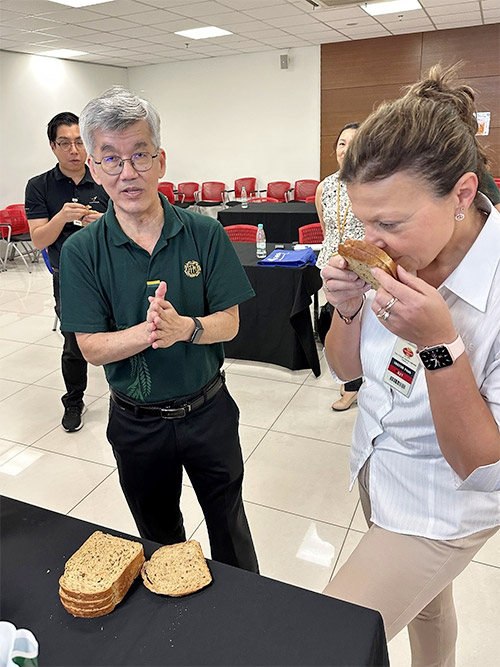 It’s always a pleasure to visit customers of Australian wheat, such as Malaysia’s Massimo: The Italian Baker, a company that is capitalising on health and wellbeing trends in the region.
It’s always a pleasure to visit customers of Australian wheat, such as Malaysia’s Massimo: The Italian Baker, a company that is capitalising on health and wellbeing trends in the region.
Massimo is Malaysia’s second largest industrial-scale bakery and holds about 15% market share, targeting niche value-added product segments such as wheat germ bread, seeded barley bread and 100% whole grain bread, partially made from Australian wheat.
According to Massimo, their barley bread was a hit, and flew off the shelves during the COVID-19 period on the back of marketing highlighting the benefits of whole grains for wellbeing.
This is in line with previous AEGIC market analysis that found Asian markets are becoming increasingly interested in the substantial health and economic benefits of increased whole grain consumption. AEGIC found that by 2030, whole grain products could be 10% of the bread market in Asia, a potential 1mmt market worth $360m in total.
Thanks to investment from the WA Government through the Department of Primary Industries and Regional Development (DPIRD), AEGIC analysis proved that Australian wheat has unique advantages for whole grain products in Asian markets.
Generally, Asian consumers prefer bright, stable colour and neutral flavours in wheat-based products. Competing wheat exporting regions like north America and the Black Sea grow red wheat, which is fine for white flour because the red bran is removed, leaving the white endosperm. However, for whole grain foods, red wheat is at a disadvantage because it can make bread and noodles darker in colour, while also giving them a bitter flavour. The white bran of Australian wheat does not have these issues, giving it a clear advantage in Asian markets.
In addition, the Grains & Legumes Nutrition Council found that Australia could save $1.4 billion in healthcare costs just by increasing whole grain consumption. When applied to the vastly more populous Asian region, the benefits would be even larger.
AEGIC has been actively communicating the benefits of Australian grains for whole grain products via webinars, workshops and information packs on how best to mill and use Australian whole grain wheat flour for Asian markets, with investment from the WA Department of Primary Industries and Regional Development (DPIRD).
We will continue to deliver workshops in South East Asia and provide customers with technical examples and evidence on how Australian wheat can be used in baking grists, including for whole grain products. Visit our Events page for more information.
AEGIC also developed targeted information packs for customers demonstrating the benefits of Australian whole grains, as well as how to efficiently mill Australian whole grain wheat flour, and guidelines for incorporating whole grains into Asian products including coconut/pandan waffles, chocolate oat cookies, youtiao (fried dough) and dried noodles.
All this evidence adds up to a compelling case for why customers should be choosing Australian wheat for whole grains. The material is appreciated by Australia’s grain customers and increases the probability that they will select Australian wheat for whole grain flour as demand increases.



AEGIC is an initiative of the Western Australian State Government and Grains Australia.


